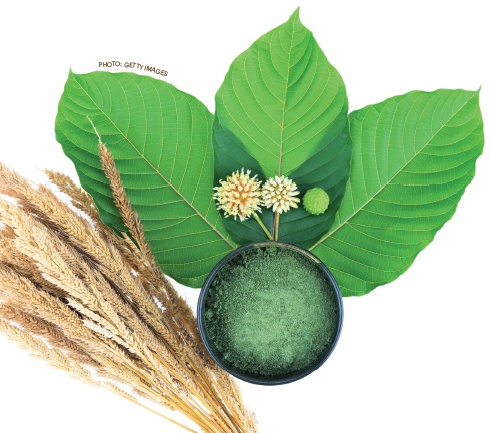
Yen Nien Hou, PharmD, DipIOM, LAc

Jyothirmai Gubili, MS
The ASCO Post’s Integrative Oncology series is intended to facilitate the availability of evidence-based information on integrative and complementary therapies sometimes used by patients with cancer. In this installment, Yen Nien Hou, PharmD, DipIOM, LAc, and Jyothirmai Gubili, MS, focus on kratom—an herbal extract from a Southeast Asian tropical tree in the coffee family with a high potential for abuse—because of its increasing popularity as a pain reliever.
Scientific Name: Mitragyna speciosa
Common Names: Cratom, Ketum, Kakuam, Biak, Mitragyna, Mitragynine, Thang, Thom
Overview
A tropical tree prevalent in Southeast Asia, kratom has a long history of medicinal use. Its leaves are chewed, smoked, or used to make tea for stimulant effects. They are also used for wound healing, to relieve diarrhea, to reduce pain and fever, and as a substitute for opium. Kratom has recently gained popularity in the United States as a pain reliever, a mood enhancer, and as an alternative for treating opioid withdrawal. However, its use has been associated with severe adverse effects, along with a high potential for abuse. Kratom is banned in several states in the United States and in some countries.
The U.S. Food and Drug Administration (FDA) has also recently warned companies marketing kratom with false claims of preventing or treating COVID-19 infection.1
The Science
Preclinical studies have shown that kratom has muscle relaxant,2 anti-inflammatory,3 analgesic,4 anorectic,5 and morphine-like6 effects.
Clinical data on kratom are limited. Kratom was reported to exert stimulant effects at low doses (1–5 g), whereas pain-relieving and sedative properties were observed at higher doses (5–15 g).7 These effects occur within 5 to 10 minutes after ingestion and may persist for 2 to 5 hours.8

Pharmacologic studies found the alkaloids mitragynine and 7-hydroxymitragynine to be the chief bioactive compounds.9 Both produce central nervous system stimulant and depressant effects via monoaminergic and opioid receptors.10,11 They also mimic opioids, as evidenced by their affinity for opioid receptors, competitive interaction with naloxone (a medication used to reverse opioid overdose), as well as analgesic cross-tolerance.12 In addition, mitragynine can cause addiction profiles similar to those of morphine and cognitive impairment.13
Adverse Reactions
Symptoms associated with kratom withdrawal include nausea, vomiting, chills, sweats, muscle spasms and pain, decreased appetite, diarrhea, anxiety, irritability, depressed mood, hot flashes, and sleeping difficulty.14-16
Liver injury has been reported following prolonged use of kratom.17-19
Cardiotoxicity was observed as a result of ingesting kratom.20-22
Several deaths have been associated with the use of kratom-containing products or polydrug use in which kratom was believed to play a role.23-31
Herb-Drug Interactions
Cytochrome P450 (CYP450) Substrates: There is a potential for increased clearance of drugs metabolized by CYP450 substrates in kratom users.32,33 Kratom may also inhibit CYP2D634 and induce CYP1A2.35
UGT (uridine 5’-diphospho-glucuronosyltransferase) Substrates: There is also potential for increased clearance of drugs metabolized by UGT1A6 with kratom use.32
P-glycoprotein Substrates: Mitragynine inhibits P-glycoprotein in vitro. Therefore, simultaneous administration of mitragynine with psychoactive drugs that are P-glycoprotein substrates may cause severe toxicity.36
Summary
Kratom is a controversial agent whose physiologic effects have yet to be fully characterized. It was placed on the “drugs of concern” list by the Drug Enforcement Administration37 and labeled as an “emerging drug of abuse” by the National Institute of Drug Abuse.38 Also, the FDA issued a public health advisory against its use, citing the potential for abuse.23 Despite these warnings, kratom continues to be widely marketed on the Internet.
Guest Editor

Jun J. Mao, MD, MSCE
Integrative Oncology is guest edited by Jun J. Mao, MD, MSCE, Laurance S. Rockefeller Chair in Integrative Medicine and Chief of Integrative Medicine Service at Memorial Sloan Kettering Cancer Center, New York.
It is critical for health-care providers to be familiar with kratom. Suggested strategies for managing patients who abuse kratom include prevention of organ damage, alleviation of acute kratom withdrawal symptoms, and long-term maintenance of sobriety.39
DISCLOSURE: Dr. Hou and Ms. Gubili reported no conflicts of interest.
REFERENCES
1. U.S. Food and Drug Administration: The Golden Road Kratom. May 15, 2020. Available at https://www.fda.gov/inspections-compliance-enforcement-and-criminal-investigations/warning-letters/golden-road-kratom-607627-05152020. Accessed on February 9, 2021.
2. Chittrakarn S, Keawpradub N, Sawangjaroen K, et al. The neuromuscular blockade produced by pure alkaloid, mitragynine and methanol extract of kratom leaves (Mitragyna speciosa Korth.). J Ethnopharmacol 129:344-349, 2010.
3. Shaik Mossadeq WM, Sulaiman MR, Tengku Mohamad TA, et al: Anti-inflammatory and antinociceptive effects of Mitragyna speciosa Korth methanolic extract. Med Princ Pract 18:378-384, 2009.
4. Takayama H: Chemistry and pharmacology of analgesic indole alkaloids from the rubiaceous plant, Mitragyna speciosa. Chem Pharm Bull (Tokyo) 52:916-928, 2004.
5. Kumarnsit E, Keawpradub N, Nuankaew W: Acute and long-term effects of alkaloid extract of Mitragyna speciosa on food and water intake and body weight in rats. Fitoterapia 77:339-345, 2006.
6. Sabetghadam A, Ramanathan S, Sasidharan S, et al: Subchronic exposure to mitragynine, the principal alkaloid of Mitragyna speciosa, in rats. J Ethnopharmacol 146:815-823, 2013.
7. Chang-Chien GC, Odonkor CA, Amorapanth P: Is kratom the new ‘legal high’ on the block? The case of an emerging opioid receptor agonist with substance abuse potential. Pain Physician 20:E195-E198, 2017.
8. Diep J, Chin DT, Gupta S, et al: Kratom, an emerging drug of abuse: A case report of overdose and management of withdrawal. A A Pract 10:192-194, 2018.
9. Hayden Griffin 3rd O, Daniels JA, Gardner EA: Do you get what you paid for? An examination of products advertised as kratom. J Psychoactive Drugs 48:330-335, 2016.
10. Warner ML, Kaufman NC, Grundmann O: The pharmacology and toxicology of kratom: From traditional herb to drug of abuse. Int J Legal Med 130:127-138, 2016.
11. Rech MA, Donahey E, Cappiello Dziedzic JM, et al: New drugs of abuse. Pharmacotherapy 35:189-197, 2015.
12. Raffa RB, Beckett JR, Brahmbhatt VN, et al: Orally active opioid compounds from a non-poppy source. J Med Chem 56:4840-4848, 2013.
13. Yusoff NHM, Suhaimi FW, Vadivelu RK, et al: Abuse potential and adverse cognitive effects of mitragynine (kratom). Addict Biol 21:98-110, 2016.
14. Singh D, Müller CP, Vicknasingam BK: Kratom (Mitragyna speciosa) dependence, withdrawal symptoms and craving in regular users. Drug Alcohol Depend 139:132-137, 2014.
15. Swogger MT, Walsh Z: Kratom use and mental health: A systematic review. Drug Alcohol Depend 183:134-140, 2018.
16. Grundmann O: Patterns of Kratom use and health impact in the US: Results from an online survey. Drug Alcohol Depend 176:63-70, 2017.
17. Dorman C, Wong M, Khan A: Cholestatic hepatitis from prolonged kratom use: A case report. Hepatology 61:1086-1087, 2015.
18. Aldyab M, Ells PF, Bui R, et al: Kratom-induced cholestatic liver injury mimicking anti-mitochondrial antibody-negative primary biliary cholangitis: A case report and review of literature. Gastroenterology Res 12:211-215, 2019.
19. Osborne CS, Overstreet AN, Rockey DC, et al: Drug-induced liver injury caused by kratom use as an alternative pain treatment amid an ongoing opioid epidemic. J Investig Med High Impact Case Rep 7:2324709619826167, 2019.
20. Aggarwal G, Robertson E, McKinlay J, et al: Death from Kratom toxicity and the possible role of intralipid. J Intensive Care Soc 19:61-63, 2018.
21. Abdullah HMA, Haq I, Lamfers R: Cardiac arrest in a young healthy male patient secondary to kratom ingestion: Is this ‘legal high’ substance more dangerous than initially thought? BMJ Case Rep 12:e229778. 2019.
22. Lu J, Wei H, Wu J, et al: Evaluation of the cardiotoxicity of mitragynine and its analogues using human induced pluripotent stem cell–derived cardiomyocytes. PLoS One 9:e115648, 2014.
23. U.S. Food and Drug Administration: Statement from FDA Commissioner Scott Gottlieb, MD, on the agency’s scientific evidence on the presence of opioid compounds in kratom, underscoring its potential for abuse. February 6, 2018. Available at https://www.fda.gov/news-events/press-announcements/statement-fda-commissioner-scott-gottlieb-md-agencys-scientific-evidence-presence-opioid-compounds. Accessed February 9, 2021.
24. Neerman MF, Frost RE, Deking J: A drug fatality involving Kratom. J Forensic Sci 58(suppl 1):S278-S279, 2013.
25. Holler JM, Vorce SP, McDonough-Bender PC, et al: A drug toxicity death involving propylhexedrine and mitragynine. J Anal Toxicol 35:54-59, 2011.
26. Kronstrand R, Roman M, Thelander G, et al: Unintentional fatal intoxications with mitragynine and O-desmethyltramadol from the herbal blend Krypton. J Anal Toxicol 35:242-247, 2011.
27. Karinen R, Fosen JT, Rogde S, et al: An accidental poisoning with mitragynine. Forensic Sci Int 245:e29-e32, 2014.
28. Anwar M, Law R, Schier J: Notes from the field: Kratom (Mitragyna speciosa) exposures reported to poison venters – United States, 2010–2015. MMWR Morb Mortal Wkly Rep 65:748-749, 2016.
29. Hughes RL: Fatal combination of mitragynine and quetiapine: A case report with discussion of a potential herb-drug interaction. Forensic Sci Med Pathol 15:110-113, 2019.
30. Gershman K, Timm K, Frank M, et al: Deaths in Colorado attributed to kratom. N Engl J Med 380:97-98, 2019.
31. Matson M, Schenk N: Fatality of 33-year-old man involving kratom toxicity. J Forensic Sci 64:1933-1935, 2019.
32. Azizi J, Ismail S, Mansor SM: Mitragyna speciosa Korth leaves extracts induced the CYP450 catalyzed aminopyrine-N-demethylase (APND) and UDP-glucuronosyl transferase (UGT) activities in male Sprague-Dawley rat livers. Drug Metabol Drug Interact 28:95-105, 2013.
33. Maurer HH: Chemistry, pharmacology, and metabolism of emerging drugs of abuse. Ther Drug Monit 32:544-549, 2010.
34. Hanapi NA, Ismail S, Mansor SM: Inhibitory effect of mitragynine on human cytochrome P450 enzyme activities. Pharmacognosy Res 5:241-246, 2013.
35. Lim EL, Seah TC, Koe XF, et al: In vitro evaluation of cytochrome P450 induction and the inhibition potential of mitragynine, a stimulant alkaloid. Toxicol In Vitro 27:812-824, 2013.
36. Rusli N, Amanah A, Kaur G, et al: The inhibitory effects of mitragynine on P-glycoprotein in vitro. Naunyn Schmiedebergs Arch Pharmacol 392:481-496, 2019.
37. U.S. Drug Enforcement Administration: Drugs of abuse: A DEA resource guide. June 15, 2017. Available at http://www.dea.gov/pr/multimedia-library/publications/drug_of_abuse.pdf. Accessed February 9, 2021.
38. National Institute on Drug Abuse: Kratom Drug Facts. Available at https://www.drugabuse.gov/publications/drugfacts/kratom. Accessed February 9, 2021.
39. Eastlack SC, Cornett EM, Kaye AD: Kratom – Pharmacology, clinical implications, and outlook: A comprehensive review. Pain Ther 9:55-69, 2020.
Dr. Hou is Manager of the “About Herbs” website, maintained by Memorial Sloan Kettering Cancer Center’s Integrative Medicine Service, and Ms. Gubili is Editor, both at the Integrative Medicine Service, Memorial Sloan Kettering Cancer Center, New York.

